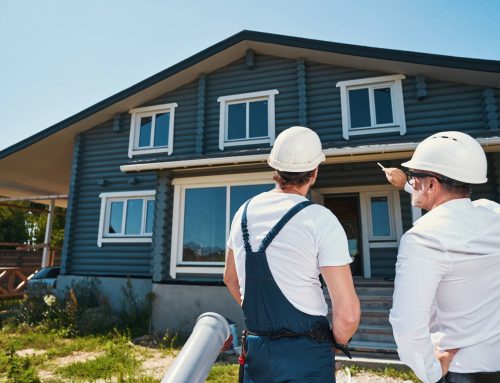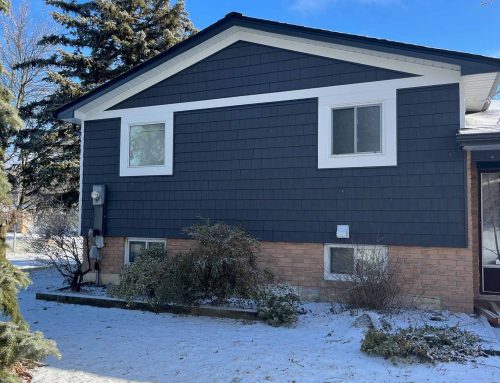Siding is the exterior cladding material applied to the outside walls of your home. It acts as a protective layer, shielding the walls from the elements, such as rain, snow, wind, and sunlight. Siding comes in various materials, each with its own levels of durability, insulation, and maintenance. As it covers the exterior walls, siding plays a crucial role in enhancing the visual appeal of your home.
Choosing the right siding for your home is important, as it directly affects the appearance, functionality, and overall well-being of your property. When selecting siding for your home, it is important to consider its climate and weather resistance, durability and longevity, maintenance requirements, aesthetic and visual impact, and overall costs.
Vinyl siding and fibre cement siding are popular choices for residential exteriors. They have similar durability and maintenance requirements but have different composition, installation requirements, and costs.
Vinyl Siding
Vinyl siding is made primarily from polyvinyl chloride (PVC) resin, which is a type of plastic. It can be a long-lasting option for the exterior of a home. Vinyl siding is known for its durability and resistance to various weather conditions. It can withstand extreme weather conditions, including both hot and cold weather conditions, without significant degradation. It is resistant to water, making it suitable for homes in areas with high humidity or frequent rain. Unlike wood siding, vinyl siding does not or warp when exposed to water. Vinyl is resistant to insects, rot, and decay, which can be a concern with certain types of wood siding. This resistance makes vinyl a practical choice in areas prone to termite or other pest issues.
This type of siding comes in a wide range of styles, colors, and textures. The versatility of vinyl allows you to choose a look that complements the architectural style of your home and meets your aesthetic preferences. Vinyl siding can be designed to mimic the look of traditional wood siding without the maintenance requirements of wood. Unlike wood siding, vinyl does not need to be painted or stained regularly. It can be cleaned with a hose and a mild soap to remove dirt and debris. If you want a siding material that does not require frequent painting, staining, or extensive upkeep, vinyl could be a practical choice.
In general, vinyl siding is relatively easy to install, and the installation process is often quicker compared to other siding materials. This can result in lower labor costs and less disruption during the installation. Furthermore, some vinyl siding products come with built-in insulation options, contributing to improved energy efficiency in your home. Insulated vinyl siding can help regulate indoor temperatures and potentially reduce energy costs. If you are looking for an affordable siding option, vinyl is often more budget-friendly than other materials. Vinyl provides a good balance between cost and durability.
Fibre Cement Siding
Fibre cement siding is typically made from a mixture of cement, sand, and cellulose fibres. The cellulose fibers, often derived from wood, enhance the strength and flexibility of the material. Fibre cement siding is highly durable and can withstand a variety of environmental conditions, including harsh weather, UV rays, and insects. This type of siding material is resistant to moisture, which helps prevent issues, such as rot and decay. Furthermore, fibre cement is non-combustible and has excellent fire-resistant properties. This makes it a suitable choice for areas where fire safety is a concern. If you live in an area with harsh weather conditions or prone to wildfires, fibre cement can be a suitable option for your home’s siding.
Like vinyl siding, fibre cement siding requires relatively low maintenance. It does not need regular painting or staining, and it is resistant to common issues, such as rot, warping, and insect damage. Fibre cement siding is available in a range of styles and textures, including options that closely resemble wood or stucco. If you appreciate the look of wood but want a more durable and low-maintenance alternative, fibre cement siding can be a good option for you. Fibre cement siding is often pre-painted or pre-stained during the manufacturing process, providing a durable and consistent finish. With various styles and textures available, fibre cement siding allows homeowners to achieve their desired aesthetic without the maintenance challenges associated with some natural materials.
Some fibre cement products come with integrated insulation options, contributing to the home’s energy efficiency. Fibre cement incorporates sustainable materials and can be recycled. As such, fibre cement is generally considered as an environmentally-friendly option compared to other siding materials. Installing fibre cement siding requires some skill and experience. Fibre cement is relatively heavy, and proper installation is crucial for long-term performance. It is often recommended to have this type of siding installed by professionals. If you are looking for a siding material with a long lifespan and potential for a good return on investment, fibre cement siding can be a solid choice when properly installed and maintained.
The choice between vinyl siding and fibre cement siding depends on factors such as budget, aesthetic preferences, climate, and the level of maintenance and durability desired. As a homeowner, you should carefully weigh these considerations to determine which siding material best suits your needs.






